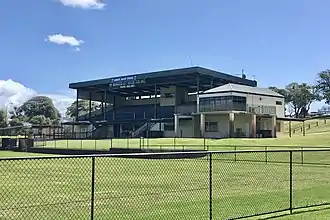Frank Drago Reserve
Frank Drago Reserve is a sports reserve in Bayswater, a suburb of Perth, Western Australia. It is home to the Bayswater City Soccer Club, Bayswater Bowls and Recreation Club, Bayswater Croquet Club and Bayswater Tennis Club.
 Gerry Maio Stand in October 2021 | |
| Former names | The recreation ground Bayswater Oval |
|---|---|
| Address | Corner Whatley Crescent and Garratt Road, Bayswater, Western Australia Australia |
| Coordinates | 31.922°S 115.907°E |
| Owner | Government of Western Australia |
| Operator | City of Bayswater |
| Type | Multipurpose sporting complex |
| Current use | Soccer, tennis, croquet, bowls |
| Opened | 22 February 1907 |
Clubs and facilities
Frank Drago Reserve is home to the Bayswater City Soccer Club, which competes in the National Premier Leagues Western Australia, Bayswater Bowls and Recreation Club, Bayswater Croquet Club and Bayswater Tennis Club.[1]
Facilities for soccer are two main pitches, used for games, and two small pitches, used for training. The Gerry Maio stand overlooks these pitches.[1] On the southern side of the reserve, on Murray Street, is the facilities for tennis, croquet and lawn bowls. The tennis club has clay courts, hard courts and grass courts, as well as a clubroom.[1] All outdoors sports facilities have floodlighting.[1]
The reserve is owned by the Government of Western Australia, but is managed by the City of Bayswater.[2]
History
In 1904, the land on and around the present day Frank Drago Reserve was purchased by Gold Estates of Australia Pty Ltd, a real estate company, for subdivision. The Bayswater Road Board (predecessor to the City of Bayswater) was looking at purchasing land for recreation and for a new hall, and Gold Estates wanted these facilities to be next to their land, so they sold part of the land to the road board at a low price, under the condition that those facilities were built within a certain timeframe.[3]: 134–135 The ground was officially known as Bayswater Oval, but unofficially called "the rec" or "the recreation ground" by local residents. Prior to the 1950s, the Bayswater Oval was used for cricket and Australian rules football.[3]: 61 On 22 February 1907, the recreation ground and hall was officially opened by James Brebber, the state's Minister for Works. The following day, 700 people attended the recreation ground for several sports being played.[4]
During the early 1930s, the bowling and croquet clubs were formed. In 1932, several more lots were purchased from Gold Estates in order to expand the recreation ground.[3]: 176
In 1952, the Bayswater Road Board made the controversial decision to lease out the oval to the WA Soccer Association for use as its home ground. The ground was leased out so that some of the cost of maintaining the oval was recouped. Later that decade, a grandstand was purchased from Perth Oval, and was reconstructed at Bayswater.[3]: 234
Bayswater United moved to the ground in 1966, having played in Mount Hawthorn since being founded in 1961.[5]
In 2000, Bayswater Oval was renamed to Frank Drago Reserve, after Francesco Maria Drago, long serving manager of the City of Bayswater's parks and gardens team.[4]
In August 2021, the grandstand was renamed to the Gerry Maio Stand, after the soccer club's president, who had died earlier that month.[6][7]
References
- "Frank Drago Reserve". City of Bayswater. Retrieved 13 January 2022.
- Lim, Kristie (10 April 2019). "Bayswater City Soccer Club gains council support for $16m redevelopment". PerthNow. Retrieved 13 January 2022.
- May, Catherine (2013). Changes they've seen : the city and people of Bayswater 1827-2013. Morley, W.A.: City of Bayswater. ISBN 9780646596082.
- "Local Heritage Survey". City of Bayswater. pp. 331–333. Retrieved 13 January 2022.
- "The History Of The Bayswater City Soccer Club Est.1961". Bayswater City Soccer Club. Retrieved 13 January 2022.
- Smith, Ben (19 August 2021). "NPL: Bayswater City pay tribute to late president Gerry Maio with 7-0 thumping of Gwelup Croatia". PerthNow. Retrieved 13 January 2022.
- Klucznick, Brett (14 August 2021). "Vale Gerry Maio". Football Hall of Fame Western Australia. Retrieved 13 January 2022.